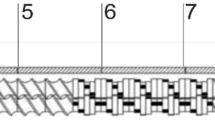Abstract
Biodegradable polyfurfuryl alcohol (PFA)-based bioplastics, containing 0.5% to 3% (w/v) dissolvable polylactic acid (PLA) fabric, were successfully fabricated with p-toluene sulphonic acid as an acid catalyst by casting method in a silicon mould. By incorporating PLA, the 1st step thermal curing time of acid-catalysed furfuryl alcohol decreased from 96 h to 22 h. The fabricated bioplastics were characterized by Fourier transform infrared spectroscopy, scanning electron microscopy, thermogravimetric analysis, differential scanning calorimetry and tensile testing to evaluate their structure and properties. The results revealed that PFA-based bioplastics with 0.5% PLA showed higher tensile strength as well as higher elongation at break compared to neat PFA-based bioplastics. Also, the thermal stability of PFA bioplastic at 0.5% PLA increased compared to neat PFA. A “green” and solvent-free method for incorporating PLA in PFA resin to fabricate PLA incorporated PFA-based bioplastics has been delineated in this work.












Similar content being viewed by others
References
Klemm D, Heublein B, Fink HP, Bohn A. Cellulose: fascinating biopolymer and sustainable raw material. Ang Chem Int Ed. 2005;44:3358–93.
Gandini A. The irruption of polymers from renewable resources on the scene of macromolecular science and technology. Green Chem. 2011;13:1061–83.
Martin O, Averous L. Poly(lactic acid): plasticization and properties of biodegradable multiphase systems. Polymer. 2001;42:6209–19.
Oyama HT. Super-tough poly(lactic acid) materials: reactive blending with ethylene copolymer. Polymer. 2009;50:747–51.
Gandini A, Belgacem MN. Furans in polymer chemistry. Prog Polym Sci. 1997;22:1203–379.
Gandini A. Polymers from renewable resources: a challenge for the future of macromolecular materials. Macromolecules. 2008;41:9491–504.
Wang H, Yao J. Use of poly(furfuryl alcohol) in the fabrication of nanostructured carbons and nanocomposites. Ind Eng Chem Res. 2006;45:6393–404.
Guigo N, Mija A, Vincent L, Sbirrazzuoli N. Eco-friendly composite resins based on renewable biomass resources: polyfurfuryl alcohol/lignin thermosets. Eur Polym J. 2010;46:1016–23.
Yuyan R, Li Yingmin. Substitute materials of furfuryl alcohol in furan resin used for foundry and their technical properties. China Foundry. 2009;6:339–42.
http://kebony.com/en/content/technology. Accessed 7 Sept 2016.
Principe M, Ortiz P, Martinez R. An NMR study of poly(furfuryl alcohol) prepared with p-toluenesulphonic acid. Polym Int. 1999;48:637–41.
Principe M, Martinez R, Ortiz P, Rieumont J. The polymerization of furfuryl alcohol with p-toluenesulfonic acid: photocross-linkeable feature of the polymer. Polímeros: Ciência e Tecnologia. 2000;10:8–14.
Kumar R, Kumar R, Anandjiwala RD. Biofilms from polyfurfuryl alcohol adsorbed on soy protein isolate. Plast Rubber Compos Macromol Eng. 2012;41:1–7.
Kumar R, Anandjiwala RD. Compression moulded flax fabric reinforced polyfurfuryl alcohol bio-composites: mechanical and thermal properties. J Therm Anal Calor. 2013;112:755–60.
Kumar R, Anandjiwala RD. Polyfurfuryl alcohol products. South Africa Patent Application. 2011;ZA2011/01976.
Kumar R, Anandjiwala RD. Process for preparing polyfurfuryl alcohol products. WIPO. 2012;WO 2012/123902 A1.
Kumar R. Polyfurfuryl alcohol—a waste from sugarcane bagasse as a construction material, In International Conference on Construction Materials and Structures, Johannesburg, South Africa 2014;461–65.
Jones AR, Watkins CA, White SR, Sottos NR. Self-healing thermoplastic-toughened epoxy. Polymer. 2015;74:254–61.
Johnsen BB, Kinloch AJ, Taylor AC. Toughness of syndiotactic polystyrene/epoxy polymer blends: microstructure and toughening mechanisms. Polymer. 2005;46:7352–69.
Ollier R, Stocchi A, Rodriguez E, Alvarez V. Effect of thermoplastic incorporation on the performance of thermosetting matrix. Mater Sci Appl. 2012;3:442–7.
Yang H-S. Thermal and dynamic mechanical thermal analysis of lignocellulosic material-filled polyethylene bio-composites. J Therm Anal Calorim. 2017;130:1345–55.
Blanco I, Cicala G, Latteri A, Saccullo G, El-Sabbagh AMM, Ziegmann G. Thermal characterization of a series of lignin-based polypropylene blends. J Therm Anal Calorim. 2017;127:147–53.
Cicala G, Saccullo G, Blanco I, Samal S, Battiato S, Dattilo S, Saake B. Polylactide/lignin blends: effects of processing conditions on structure and thermo-mechanical properties. J Therm Anal Calorim. 2017;130:515–24.
Kumar R, Moyo D. Fabrication and properties of PLA fabric based sandwich panels with arylated soy protein isolate as the binder. J Biobased Mater Bio. 2012;6:521–30.
Yao J, Wang H, Liu J, Chan K-Y, Zhang L, Xu N. Preparation of colloidal microporous carbon spheres from furfuryl alcohol. Carbon. 2005;43:1709–15.
Domínguez JC, Grivel JC, Madsen B. Study on the non-isothermal curing kinetics of a polyfurfuryl alcohol bioresin by DSC using different amounts of catalyst. Thermochim Acta. 2012;529:29–35.
Burket CL, Rajagopalan R, Marencic AP, Dronvajjala K, Foley HC. Genesis of porosity in polyfurfuryl alcohol derived nanoporous carbon. Carbon. 2006;44:2957–63.
Yang W, Fortunati E, Dominici F, Kenny JM, Puglia D. Effect of processing conditions and lignin content on thermal, mechanical and degradative behavior of lignin nanoparticles/polylactic (acid) bionanocomposites prepared by melt extrusion and solvent casting. Eur Polym J. 2015;71:126–39.
Ahmad EEM, Luyt AS, Djokovic V. Thermal and dynamic mechanical properties of bio-based poly(furfuryl alcohol)/sisal whiskers nanocomposites. Polym Bull. 2013;70:1265–76.
Mu C, Xue L, Zhu J, Jiang M, Zhou Z. Mechanical and thermal properties of toughened poly (L-lactic) acid and lignin blends. BioResources. 2014;9:5557–66.
Chuensangjun C, Pechyen C, Sirisansaneeyakula S. Degradation behaviors of different blends of polylactic acid buried in soil. Energy Procedia. 2013;34:73–82.
Author information
Authors and Affiliations
Corresponding author
Rights and permissions
About this article
Cite this article
Sharib, M., Kumar, R. & Kumar, K.D. Polylactic acid incorporated polyfurfuryl alcohol bioplastics: thermal, mechanical and curing studies. J Therm Anal Calorim 132, 1593–1600 (2018). https://doi.org/10.1007/s10973-018-7087-0
Received:
Accepted:
Published:
Issue Date:
DOI: https://doi.org/10.1007/s10973-018-7087-0




